DOWNTOWN / UNIVERSITY / 4TH AVE
“Bycatch” – An Artistic Homage to the Throwaways

Shame-faced Crab illustration by Maria Johnson.
The sound of waves lapping on the side of a fishing boat sonically greets you when entering the Hanson Gallery at The University of Arizona Museum of Art. It emanates from a small computer speaker in the corner, subtly broadcasting the audio associated with the 14-foot-wide, 10-foot-tall video projection on the room’s east wall.
As you turn to watch the video projection, your eyes pause to take in the bar table in the middle of the room. Maybe you salivate a bit when you see the faux shrimp cocktail presentation adorning the table, complete with white wine glasses, red napkins and poetic menus. Maybe you imagine yourself sitting on one of those black bar stools and squeezing lemon on the tasty crustacean before dipping it into cocktail sauce and popping it into your mouth, slowly savoring the meaty delicacy. But your eyes are pulled to the east wall, to watch the projection of what takes place in order to bring this delightfully delicious arthropod to our collective plates and our – seemingly insatiable – palates.
The 11-minute video is a montage of excerpts filmed on a Gulf of California shrimp trawler, a vessel that drags several nets along the sea floor to capture brown shrimp during the night when the shrimp are bedded down in the aquatic bottom, scientifically known as the benthic zone. The projection brings powerful moving imagery to the gallery’s multimedia “Bycatch” exhibit that features gorgeously detailed ink on Bristol paper illustrations by Maria Johnson, a marine conservationist and Prescott College adjunct professor. Accompanying her work is poignant poetry by Eric Magrane, who is both a PhD candidate in UA’s School of Geography and Development and a research associate with UA’s Institute of the Environment.
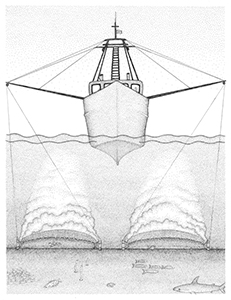
Trawler illustraion by Maria Johnson.
Johnson’s visual art and Magrane’s poetry pay homage to the sea creatures considered basura (trash) by the fisheries. Organisms such as crabs, turtles, eels, sting rays, sea horses and numerous fish species are the incidental casualties – comprising over 80% of what is caught in the nets – shoveled overboard to waiting sea lions and pelicans once the shrimp are sorted out from the writhing mass of beings dropped from the nets onto the boat decks.
The complement of illustrations, poetry and video draw you into a world of sea life, and sea death. It showcases the hidden actors, the bycatch, in this larger international economic drama. A drama that Johnson and Magrane were invited to document and catalogue as scientific observers on a Mexican fishing vessel through Prescott College’s Kino Bay Center for Cultural and Ecological Studies program.
In conversation with Johnson and Magrane, the two talk about the countless intricacies associated with the Gulf of California’s shrimp trawling industry. “As a geographer, I think about the multiple ways of trying to make some sense of what’s happening on the boat, because there is that process of being knee-deep in the fish, but then there’s global economic processes that are embodied in this interaction that is happening,” Magrane conveys. “It’s a way for humans to make a living. Although, most, if not all, of the people that work on the boats do not own the boats. There’s an effect that this has on the local and smaller scale fisher people of the region and the indigenous communities of the region, so it gets very complicated very quickly.”
As American consumers removed from the region’s fiscal realities, it may be easy enough to decide to stop consuming shrimp, to not be a part of this extractive industry and wonder how people can choose to earn their living by participating in disruptive ecological devastation. But the fact is, people are going to – understandably – do what they need to do to feed their families.
“The communities around the Gulf of California are so heavily focused on fishing, whether it’s large scale like trawling or tuna fishing or whether it is small scale,” Johnson explains. “It’s hard to find other (employment) options and fishing is a tradition. Many of the people working on the boats… it’s what their fathers did and it’s the life they have gone into for whatever reason.”
The other reality is the “very significant cultural differences, where different groups of people interact with different animals in different ways. You have some cultures where fish are food and that’s the only food that’s there. And some groups of people keep fish in aquariums. Or, we relate to cows in different ways, we relate to all these different species in different ways on this cultural and individual level,” Johnson elucidates.
Johnson and Magrane speak with compassion when discussing the industry’s players. They have reverence for the people who cast the nets, they feel for the creatures needlessly dying. I wonder how it is to be on the deck, cataloguing the organisms as they suffocate to death.
“You have to leave a part of your compassion in this other place and come back to it later, or at least that’s how I sometimes interact with it because if I’m just purely myself as a feeling and sensitive person on that boat, I just want to throw everything off board and save every little creature and cry, because it is so intense,” Johnson shares. “But you’re there and you have a job to do and you’re with people who do this for a living, and you want to respect that and collect data and have conversations, so I feel myself kind of leaving a part of that onshore and coming back to it.”
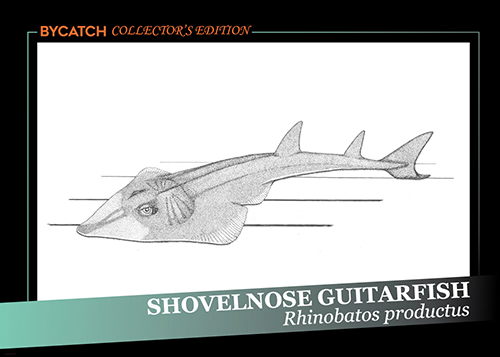
Shovelnose Guitarfish illustration by Maria Johnson.
Courtesy of Maria Johnson
“I think of the role of art and poetry and social science and social theory, in some sense, as being a way to pay witness to what is happening,” Magrane adds. “What going at this project through poetry and art does for me is to try to make some sort of sense, some sort of marking of this relationship that is being played out on the boat.”
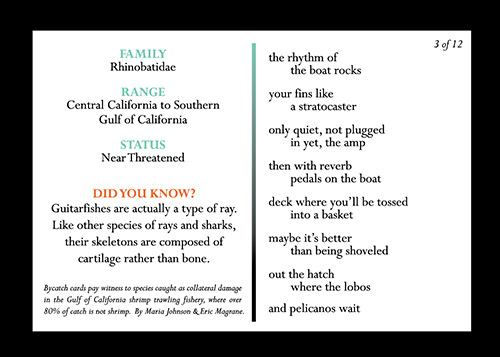
Poem by Eric Magrane.
Courtesy of Maria Johnson
“I know that a lot of what Eric and I have tried to do with this project, as Eric was saying about paying witness to these, not only the species (collectively) but these individuals both through poetry and through illustration, it’s been a really beautiful process. Going back to what I was saying earlier about leaving that compassion at home, this project has been a way for me to come back to that and really physically sit down and spend time with an actual individual (creature) that maybe we encountered in 2015, or that I encountered in 2013, that I actually remember, or that we actually weighed and measured and maybe we have a photo of it or maybe it’s something in our minds, or we remember that feeling of that fish’s slime on our hands or the way that it moved,” Johnson says, regarding their artistic processes. “Then to translate that into illustration and into poetry and honor and respect those individuals and those species, that’s been this very meaningful part of this project to me, that’s given me an opportunity to slow down and look at them as individuals and kind of make room to give that life space again, just in a different way.”
A unique aspect of the exhibit is the 3.5 by 2.5-inch trading cards on display, which are available for $10 in the museum’s store. They include Johnson’s drawings and excerpts of Magrane’s poetry of rolling couplets. (The poetic form, explains Magrane, was inspired by “the experience of being on the boat, the lull, the boat rolling on the water, the movement in that space.”) The idea behind the trading cards was based on Catholic remembrance cards, baseball cards and lotería cards.
“It’s both riffing off of baseball cards or trading cards and the back (of these cards) riffs off it too with the facts about the species along with excerpts from the poems. But the idea of using this form, a collector’s edition for something that is basura, plays against that,” Magrane shares. “Because bycatch, almost by definition, is not valued, it’s the leftover, it’s the waste. So, using the form of the collector’s edition trading cards kind of critiques that in a sense, puts a different play on that, there’s a little bit of cognitive dissonance with that there.”
“Bycatch” grew out of Johnson and Magrane’s involvement with the 6&6 Artists|Scientists project, which is an offshoot of the Next Generation Sonoran Desert Researchers (N-Gen) interdisciplinary network “of individuals and institutions committed to the rich social and ecological landscape that spans the mainland Sonoran Desert, the Baja California Peninsula, the Gulf of California, and the US-Mexico borderlands,” according to the NextGenSD.com website. Find details on the “Bycatch” project at NextGensd6and6.com.
The exhibit is on display through April 2 at the UA Museum of Art, 1031 N. Olive Rd. Call 520-621-7567 or visit ArtMuseum.arizona.edu for hours and admission prices. Pick up the March/April issue of Edible Baja Arizona to see several “Bycatch” illustrations and poems.
Life of Art/Art of Life
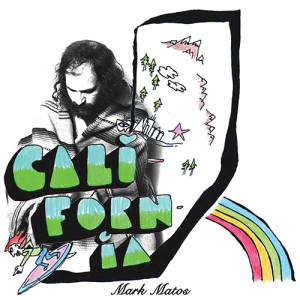 Mark Matos
Mark Matos
California
Lonesome Desert Records, 2017
Gorgeously soul-weary and deeply personal, this 9-track album features acoustic guitar and vocal-driven narratives of remembrance, connection and loss. The introspection is carried with gentle tension; there’s pain, delivered with acceptance.
Matos offers mythological motifs1 from ancient stories that are still universally applicable in modernity. He writes about addiction2 and death3. There’s a yearning beautifully balanced vocally with Buddhist temperament4. Matos’ lyrics bring magical realism5, and musings on rebellion6 that culminate in self-realization7 and wry reflections8.
Written between 2011 and 2015, and recorded at the end of 2015, Matos verifies the songs “are almost uncomfortably autobiographical. Maybe why I recorded them the way I did: lo-fi, by myself, sparse.
“I was alone with an 8-track recorder and a couple of guitars and would wake up and make coffee and start recording; 12 or 14 hours later I would fall asleep and then wake up and do it again. I didn’t see or talk to anyone during the recording, I was in a kind of fugue, in a parallel universe of my own design. Sitting in the kitchen of my youth, floating through my memories, a 40-year-old art lifer staring at the odd fitting pieces of his personal puzzle and slowly, methodically, trying to put the puzzle together, to see the picture.”
To craft these recordings solo, to do his own backing vocals and layer the sounds into a delicate aural tapestry is stirring. His mental/spiritual disposition and recording process created an emotionally affecting album that sonically lulls the listener into a contemplative, day-dream state. It echoes in our souls’ imaginations and individual experiences. We know who these people are. They are us, and our friends, as we collectively navigate life’s confusing intricacies.
Matos performs a free show on Sunday, March 5, 4 p.m., at Che’s Lounge, 350 N. 4th Ave. Visit NewWeirdWest.com for information on Matos and his current projects. Preview and purchase the album at NewWeirdWest.bandcamp.com/album/california.
- There’s an oak tree up ahead/And it’s burning in the night/Adding fire to the darkness/And spirit to the fight – “Visions of You”
- Fire to glass, but it never lasts/That’s the bitch of it, just one more hit – “Fire to Glass”
- Behind you the gates are locking/Native son – “Season of Impermanence”
- You are the water, you are the fountain/You are the climber, you are the mountain/And we can ride/Side by side/Looking for a home where the light always shines – “California”
- You keep stones in your pocket/To protect you from this noise – “Little Wind”
- But he won’t be long for that farm/He’s a country boy with a hunter’s song – “Show Me a Gun”
- I’d like to get back to planting in the moonlight/Working on the house/Walk away from this Greenwich Time – “Had It All and Lost It”
- But the locks on the doors of your mind leave you nowhere to run – “Collateral Mind”
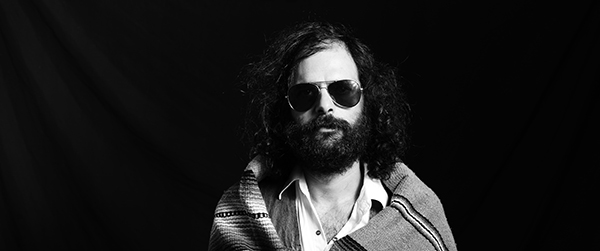
Mark Matos
Photo by Basil Glew-Galloway
Following is an edited Q&A with Matos, conducted over email.
Are the individual songs composites of experiences or do they reflect particular moments in time? Thinking about “Season of Impermanence” and “Fire to Glass.”
The answer is yes to both parts of the question. The songs are both composites and reflective of particular moments. “Season of Impermanence” deals with a particularly tough 2015: my longtime soundman (Kyle Lesley, who recorded Trans Van Santos’ “Moon Mirage”) passed away after a 2-year, fist-fight with cancer. My roommate ended up in San Quinton on a 2-year bid and another bandmate fell off the wagon and got caught between the Hell’s Angels and the SFPD and got 5 years out of it.
“Fire to Glass” was written on the same day as “Season…” I returned to SF to play the Dia De Los Muertos memorial show for Kyle after he passed away and found my community in spiritual disarray. A couple members of the road crew and band were holed up, I was told, in a motel in the Tenderloin smoking crack. “Fire to Glass” is kind of my “Needle and the Damage Done” (Neil Young), my cautionary tale, my “try not to smoke crack because it sucks” song.
“Show Me a Gun” and “Had It All & Lost It” feel like different moments in time with the same character, are the songs related in that way?
“Show Me A Gun” is the protagonist at the beginning of the journey, leaving home, venturing archaically into the future. Rejecting the hand he was dealt and becoming human. “Had it All & Lost It” is the protagonist at the “end” of the journey, looking back at the sacrifices made for a life of art and evaluating the consequences. The artist is considering a future where he sacrifices his “life of art” for a pastoral, solitary “Art of Life” approach.
Who brings the backing vocals? Other collaborators?
All of the vocals and instruments were recorded by me. The album probably feels so personal, in part, because of this. I had never written and performed my own vocal harmonies before this album. I think the solitude of the recording process and the personal nature of the material opened a window for me where I felt liberated to experiment with singing my own parts. I think this ends up being a big part of the “feel” of the record. I had a lot of moments of spiritual liberation reaching for and hitting those harmonies. A real sense of discovery for me personally. 25 years into this music thing and I feel blessed to still be pushing at the edges of my capabilities, to still be capable of wonder and growth.
Tour? Other news?
I gave up my room in the bay area last year and have been living a regional nomadic life for much of the past year. I had to “recalculate my course” and sacrifice stability for a while so that could keep writing, recording, connecting the dots, reaching for the magic. My tour never ends but it is the world’s Slowest Tour, I am feeling the turtle magic. I would like to go on tour sometime as a solo support act for someone I know and admire, someone like Sonny Smith or Howe (Gelb), something like that would appeal for the opportunity to keep learning from and stealing from those guys.
I am out in Joshua Tree in April to finish the new Trans Van Santos album with my running mate Matt Adams (The Blank Tapes, Burger Records). We are mixing with Nathan Sabatino at the new Loveland Studio location Joshua Tree (Saba moved the longtime Tucson studio to Joshua Tree last year.) Then to LA after the Dead Meadow tour to finish the Old Mexico album (Old Mexico is a new project co-led by Jason Simon of Dead Meadow and myself, with members of both of our bands). In spring, I start a 6 month stint as Resident Artist in Grass Valley, CA. I am going to use the time and space for a large scale project called the “Anthology of the New, Weird West,” a post-modern, pre-flood, update of Harry Smith’s Anthology of American Folk Music wherein I am cast as a Gonzo John Fahey/Harry Smith and my friends are cast as the folk singers for the future myth.
Borderlands Theater Relocates, Launches a $20K Fund Drive
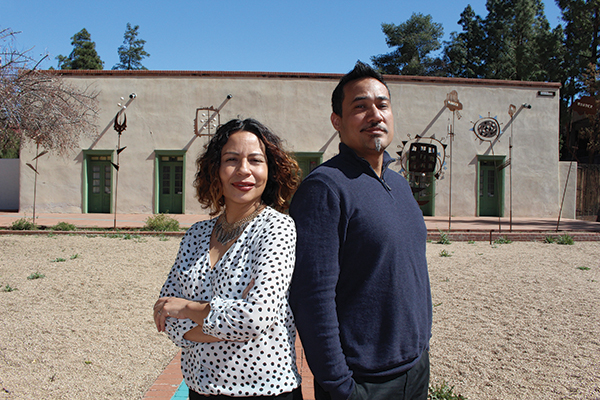
Borderlands Theater Marketing and Outreach Director Milta Ortiz (left) with Producing Director Marc Pinate (right) in front of the theater’s new office/community space, the Sosa-Carrillo-Fremont House museum, at 151 S. Granada Ave.
Photo by Gaby Hurtado
For over three decades, Borderlands Theater has survived on a shoestring budget with vitality and resilience. This pertinent production company, comprised of a four-person staff, is committed to creative innovation by presenting plays from both emerging and established playwrights. It keeps pushing the boundaries of theater by showcasing cutting-edge work in venues that range from the Temple of Music and Art’s intimate 80-seat Cabaret Theatre, to outdoor, site-specific productions that easily draw a thousand people over a weekend.
Bolstered by a team of collaborators and community partners, Borderlands illuminates often over-looked Tucson populations and brings to life diverse histories frequently swept under the rug of collective municipal memory. And because it is a local nonprofit that believes theater is for all, Borderlands regularly offers donation-based and free events.
As political action on the national scale threatens to eliminate arts funding, it is exceedingly imperative for local communities to band together and support the organizations that strive and succeed in embracing, projecting and amplifying the diverse voices comprising this unique landscape. Borderlands, as it states on the GoFundMe.com/keep-borderlands-theater-open website, relies “too heavily on national grants with no major donors to help if a grant falls through. That’s exactly what happened last November when we weren’t awarded a major National Endowment for the Arts grant (though, we won two other NEA grants this year, so not too shabby).” Accordingly, Borderlands is seeking donations to both bridge its current $20,000 deficit and plan for the future. The deadline for the company to raise the $20K is March 27, as stated on the GoFundMe.com page.
Even amid these fiscally challenging times, there is good news and recent developments! A press release from Borderlands, sent in mid-February, stated that the company had just relocated to Arizona Historical Society’s downtown Sosa-Carrillo-Fremont House museum – “the last remaining dwelling of Tucson’s original Mexican-American enclave sometimes referred to as Barrio Libre or El Hoyo.” Built in the mid-1850s by Jose Maria Sosa, the house was subsequently owned by Territorial Governor of Arizona John C. Fremont and entrepreneur Leopoldo Carrillo.
The move is fitting, in light of Borderlands’ presentation of “Barrio Stories” in March 2016, which featured theatrical vignettes of the late 1960’s Barrio Libre/El Hoyo diaspora caused by the planning and construction of the Tucson Convention Center that demolished the 80-acre neighborhood.
The press release says “the win-win partnership provides Borderlands with expanded and much needed rehearsal, storage and office space while allowing the Sosa-Carrillo-Fremont House to remain open as a museum. Several rooms in the house will remain as exhibition spaces maintained and curated by the Arizona Historical Society. The museum is open to the public during Borderlands’ office hours, Monday through Friday from 10 a.m. to 5 p.m.”
On March 23, Borderlands kicks off a music series at its new space, 151 S. Granada Ave., with a live band and poets. To learn more, visit BorderlandsTheater.org or call 520-882-8607. Donate at GoFundMe.com/keep-borderlands-theater-open.
KXCI Celebrates International Clash Day
“This is a public service announcement, with guitar!”
– Know Your Rights, The Clash, 1982

Joe Strummer of The Clash, London Calling Tower Theater Show on March 6, 1980.
Photo: John Coffey via Flickr.com
It’s been four years since Seattle’s KEXP 90.3 FM DJ John Richards declared Feb. 7 as International Clash Day, and a year since Seattle’s mayor created an official proclamation to honor The Clash on that day. Subsequently, six other cities have jumped on this punk rock proclamation bandwagon, including: Austin, San Francisco, Washington D.C., Vancouver B.C., Bridgwater U.K. and Tucson.
The date doesn’t hold special meaning in the British band’s history; Feb. 7 was just a happy happenstance of Richards spinning the band’s tunes one morning in 2013 and a listener asking him to keep The Clash’s tracks coming. However, it is the timing of the other communities getting onboard that feels significant considering the country’s current political state and the still exceedingly apropos, sneeringly poignant political songs The Clash wrote between 1976-1986.
“I think right now the spirit of The Clash and the spirit of Joe Strummer’s views ring true to a lot of cities not happy with the direction the last election went,” Richards wrote via email. “I also think some of the leaders in these cities are of an age that they clearly remember their own love of The Clash… or at the very least the respect they have for their work.”
Locally, KXCI 91.3 FM Director of Content and Home Stretch DJ Hannah Levin spearheaded the charge to create International Clash Day in Tucson. Levin, who was a KEXP DJ for eight years and moved here in fall 2014, said her KEXP colleagues approached her about getting KXCI involved this year.

“Combat Rock,” released in 1982.
“It was a no-brainer. The Clash is one of KXCI’s ‘core artists’ – music that we already play quite regularly – and the spirit of the day is very much in line with the inclusive, creative culture of Tucson,” Levin explained. “Having had the mayor on my show, I knew he (Jonathan Rothschild) was a big music fan and would likely connect with the themes embodied in International Clash Day – peace, unity, anti-imperialism, anti-racism, poverty awareness and freedom of expression.
“Now more than ever, we need to be embracing a sense of a community that welcomes people from all walks of life and celebrates the type of fearless art that brings us together, rather than divides us,” Levin elucidated. “Music has a visceral power to do that which few other art forms have, so my hope is that in addition to enjoying an avalanche of invigorating Clash-related programming, we inspire listeners to become more deeply engaged with our community around issues of social justice and freedom of expression.”
For fans of The Clash, this will be a most welcome day, and it will be an awesome education for those who are not aware of the band’s amazing body of work. KXCI is celebrating on-air from 10 a.m. to 6 p.m. with special programming that was still being finalized as of Zocalo’s press time, but Levin shared that “listeners can expect to hear Clash classics, deep cuts, rarities, and archived interviews with The Clash. We are also working on interviews with members of Tucson’s music community who were/are influenced by The Clash and/or were in attendance at The Clash’s show at the Tucson Convention Center in 1983, which was the band’s penultimate show with Mick Jones (Howe Gelb snuck into this show!).”
Che’s Lounge, 350 N. 4th Ave., is the headquarters for Tucson’s International Clash Day with DJs spinning Clash tunes that night, along with showcasing a special Clash-themed visual art show – curated by bartender/local artist Donovan White – as well as hosting a record sale of The Clash’s catalogue by Wooden Tooth Records.
Why does it matter? Well, as John Richards shared, “I think one of the main things is, they knew how to write GREAT songs. They also were lightening in a bottle like all great bands, the perfect sound and the perfect players at the perfect time. That kind of magic doesn’t just disappear.”
“There is something singular about their creative focus that is timeless – comforting and galvanizing simultaneously,” Levin added. “Whenever I hear the opening chords of ‘Know Your Rights,’ I always feel ready to be both angry and productive, which is the flavor of punk rock that has always appealed to me the most.”
Get all the event details at KXCI.org. Reconnect with the band at TheClash.com.
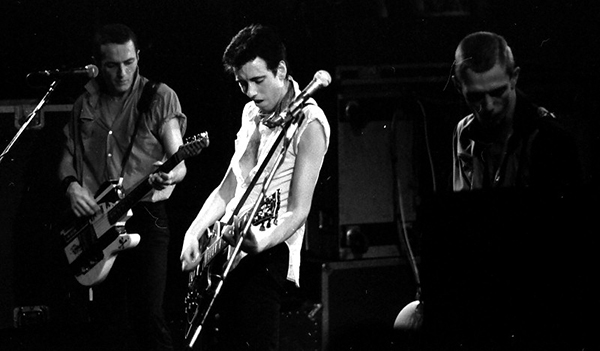
The Clash in concert, 21 May 1980. From left to right: Joe Strummer (rhythm guitar), Mick Jones (lead guitar), Paul Simonon (bass guitar). Not pictured: Topper Headon (drums).
Courtesy Chateau Neuf, Oslo, Norway via Commons.wikimedia.org
_______________________________
City of Tucson Mayoral Proclamation
WHEREAS, legendary U.K. band The Clash formed in 1976, establishing their unique sound combining punk with reggae, dub, funk, ska, and socially-conscious lyrics; and
WHEREAS, the band played the Tucson Convention Center in 1983, inspiring many Tucson musicians, including a young Howe Gelb, who formed Giant Sand that same year; and
WHEREAS, throughout their career, The Clash used the power of music to share messages of peace, unity, anti-imperialism, anti-racism, poverty awareness, and freedom of expression; and
 WHEREAS, the City of Tucson encourages all citizens to take inspiration from these messages as we work together to create an inclusive, welcoming city; and
WHEREAS, the City of Tucson encourages all citizens to take inspiration from these messages as we work together to create an inclusive, welcoming city; and
WHEREAS, the City of Tucson and the Mayor’s Office affirm that this city is a Hate Free Zone, committed to values of inclusivity, tolerance, diversity and hope; and
WHEREAS, Tucson takes great pride in its growing music community and the cultural contributions of its many musicians across a wide range of genres; and
WHEREAS, the civically-and globally-minded City of Tucson wishes to join with other like-minded cities across the globe in celebrating International Clash Day; and
WHEREAS, the City of Tucson adheres to the belief in the immortal words of Joe Strummer, “People can change anything they want to, and that means everything in the world;”
NOW, THEREFORE, I, Jonathan Rothschild, Mayor of the City of Tucson, Arizona due hereby proclaim February 7, 2017 to be
INTERNATIONAL CLASH DAY
in this community, and encourage all of our citizens to Rock the Casbah.
A Journey of the Spirit
 “My Way or the Highway”
“My Way or the Highway”
Rich Hopkins and Luminarios
San Jacinto Records, 2017 (America)
Blue Rose Records, 2017 (Europe)
The latest release from the musical mind of 30-year plus rock vet Rich Hopkins, his co-writer and multi-instrumentalist/vocalist Lisa Novak, and the band’s luminary musicians from Houston and Tucson, is an excellent addition to the regional sound of the American/Baja Southwest.
The 12-track album showcases the mature writing ability of Hopkins and Novak – an album inspired by the songwriting couple’s recent travels. Their trip to southern Mexico resulted in two tracks, “Angel of the Cascades” and “Chan Kah,” that drew from those experiences and tell beautiful stories of people and places, situated in current times and in timeless myths. The chorus of “Angel of the Cascades” is particularly hypnotic and haunting. The song invites you to imagine seeing “the smile upon his face,” as Hopkins narrates their contemplation of a beautiful pristine jungle paradise waterfall. You can look inside the CD cover and see a picture of Rich with his new friends/guides by the very pool at the base of the waterfall.
About the trip to the falls that inspired “Angel of the Cascades,” Novak says the journey “was spiritual… we really did feel like we were blessed and watched over. I was terrified on the trip and there were no directions or signs. We left there with such a humbling experience from the way some folks live in the poorest of conditions but are so sweet and happy.” You’ll feel like you are diving right into the pool with Hopkins and Novak.
“If You Want To” is a rock-out anthem to positive risk taking as Hopkins and Novak sing, “You can do it, you know you can do it, it’s always dark before the dawn.” Tucson stalwarts Winston Watson (drums), Damon Barnaby (guitars) and Duane Hollis (bass) lay down the sound around Hopkins’ trademark guitar as Novak and Hopkins’ killer chorus soar over the notes. You’ll want to play the track, which has a ‘70s country rock feel to it, over and over.
Another amazing collaboration involves poet and rapper Cesar Aguirre, which results in a rap/rock lyric flow about eye-opening redemption. The lyrics and spoken word are delivered forcefully by Aguirre, with the chorus by Novak. The cut, “Meant for Mo’,” starts with an introduction that that has my new favorite movie quote, from “School Daze” … “we aren’t so happy you got a degree in art!”
Hopkins is especially grateful to Lars Goransson, producer and recording engineer, whom, he says, helped make the record happen with available studio time that pushed the material forward.
All in all, this is a release that can’t be pigeonholed into a genre, and displays the mature power of songwriters and collaborators producing a beautiful album.
Catch Rich Hopkins and Luminarios at Flycatcher, 340 E. 6th St., on Saturday, Feb. 4 at 6 p.m. and at Fini’s Landing, 5689 N. Swan Rd., on April 7 at 8 p.m. Learn more at RichHopkinsMusic.com and ReverbNation.com/richhopkinsandtheluminarios.
¡Viva Casa Libre!
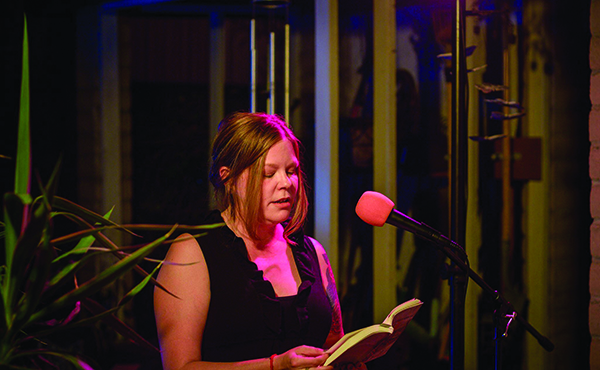
Selah Saterstrom reading at a recent Fair Weather Reading Series event.
Photo courtesy Kristen Nelson
“This is a place that has always catered to people’s passions,” explains Kristen Nelson, cofounder and current, but soon-to-be previous, executive director of literary arts nonprofit Casa Libre en la Solana.
“It’s a place where people with a passion, idea or concept could say, ‘Hey, I want to do this,’ and Casa Libre would say, ‘Yes, how can we help you?’”
Nelson makes it clear that the writing center she’s helmed for over 13 years is not closing its doors; it is going forward full steam ahead and actively searching for a new leader to carry the organization’s mission, spirit and “have the agency to create what they want with this place and incorporate what they are passionate about, what they care about.”
It’s a chilly Friday night in December, but Nelson and I stay warm under a propane heater. We’re sitting, bundled up, in the breezeway of her 1898 commercial adobe property on Fourth Avenue that shares the same name as the literary organization. Wine and snacks are being enjoyed in relaxed camaraderie because – full disclosure – Nelson and I have been professional colleagues and friends for many years. She reflects on Casa Libre’s history (inextricable from her own), what informed its creation, evolution and what the nonprofit is looking for in its new executive director when Nelson steps down on June 30, 2017.
Incorporated in July 2003, Casa Libre has operated as a connection point for the Tucson writing community for close to 14 years, offering an event space for readings, salons, book releases, workshops, fundraisers – and certainly some hell raisers – to serve groups traditionally not supported by mainstream writing outlets.
“We have tailored our vision and our mission specifically to writers of color, female writers, LGBTQIA writers, and emerging

An example of a kite made as part of “Made for Flight,” a youth project started by T.C. Tolbert at Casa Libre to commemorate the lives of murdered transgender people with kite building and poetry writing.
Photo courtesy Kristen Nelson
writers and other underserved groups,” the 38-year-old elucidates. “In the last two years, the board of directors and I recognized how important it was to have that as a stated mission and say, ‘This is why we’re here, this is your place.’ And everyone is welcome to come and be a part of that and enjoy those voices, but we want to serve these voices.”
As a queer female, Nelson is one of those voices. She shares her experiences as a youth in a multiracial neighborhood in Mount Vernon, New York and how that taught her to embrace and celebrate different perspectives. Her racially diverse community, where Nelson was in the white minority, was comprised of socially conscious families engaged in activism and connected to the larger world.
“When I was growing up, my mom got involved in this program called CISV, Children’s International Summer Villages, and we had international students live in our home for months at a time. I learned about different cultures all over the world – Costa Rica, Guatemala, Portugal, France, Spain, Taiwan, Egypt, Greece. I grew up with this sense that the United States is not centric; we are part of a world community.
“And then I just started paying attention. I recognized that I was queer somewhere around 16-years-old. I grew up in a family that was incredibly loving and supportive of who I am, they always have been – regardless of sexual identity, regardless of career path – and really believed in the concept that you can do anything you want to do.”
As Nelson navigated college and met other queer individuals and people of different races, she recognized the privilege she had even as she was personally experiencing discrimination.
“I saw my own challenges in terms of publishing, in terms of sharing my work, getting my voice heard. From my own personal experience and paying attention to other voices that were trans voices, paying attention to people of color’s voices, international voices and how much harder so many underserved groups in the world have it. I recognized that I would never be imprisoned for writing a poem and what a privilege that was. Growing up in an activist, socially conscious, super, super liberal family helped. And that taught me to pay attention, and from there, that grew.”
While at the University of Tampa – as a junior with only three semesters left on her scholarship – Nelson knew she had to change her major from marine biology to English. “I feel like college taught me to pursue my passions, it was really then that I started to identify as a writer,” Nelson shares. She jumped right into the field with a summer internship at The Village Voice in 1999, worked as a journalist post-graduation at The Rivertowns Enterprise and then 9/11 happened.
Nelson describes New York City as being in chaos and how her sources were calling to describe the violence happening against Muslims and people who were presumed to be Muslim, articles she knew were important to write. But her publisher refused to print those stories, saying the charged topics were too political.
“I thought, ‘This isn’t why I am a journalist. I’m a journalist to tell the truth, I’m a journalist to report.’ I took that really seriously. When I left New York, I was jaded after that experience and decided I wanted to work in a different field. I wound up, because of my science background, getting a job (eight months after arriving in Tucson) at what is now UA’s Institute of the Environment.”
It was the idea of starting Casa Libre with her then-partner that brought the two of them to Tucson in April 2003. The couple had envisioned an organization that would serve as both a community center and a space to host writers’ residencies – which is exactly what they did.
She explains that they were “looking for a fresh start in a place that had a vibrant queer community, a vibrant arts community, and a sense of opportunity about it. The literary community here was already so rad. Kore Press had been around for 10 years already; the Poetry Center was thriving and raising money to build their new building at the time. Spork Press, Chax Press, POG, Tucson Poetry Festival, all of these organizations really embraced Casa Libre. When I started to meet the folks running those organizations, they were excited to collaborate and support something new. In particular at the time, the Poetry Center and Kore Press – Lisa Bowden was such a huge supporter of Casa Libre from the beginning – so it felt like there were these big sisters and brothers and siblings that were out there going, ‘Come on, you can do this here.’ I felt really engaged from the beginning. It turned from a concept, a dream and a website within a year to an organization.”
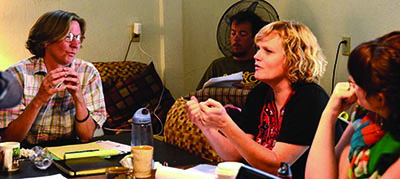
Weekend writing residency led by Rebecca Brown, left; also pictured are Frankie Rollins (center), T.C. Tolbert (background) and Lisa O’Neill (far right).
Photo courtesy Kristen Nelson
Casa Libre’s writer residency program worked for several years, during a period when Nelson was able to secure scholarships through private donations for the winning grantees. When the Great Recession hit in late 2008, the private funding streams dried up and Nelson turned the short-term writers’ residencies into long-term artist live/work spaces over a period of two years.
Throughout Casa Libre’s existence, it has continually strived to adapt to the changing needs of Tucson’s community by hosting meetings to discuss the organization’s role in serving the writing populace. “If you want to know how to better serve your community,” says Nelson. “Ask your community. There’s no mystery there.”
Lisa Bowden, Kore Press’ publisher/cofounder and a longtime collaborator with Nelson, describes Casa Libre as being “a vital center in the community for the literary arts, for discussion and exchange of ideas. An incredible, glowing, magnificent force.” Bowden also shares that partnerships between Kore Press and Casa Libre have included various community projects, activism workshops for youth, along with holding other writing workshops in Casa’s library.
There’s been a bevy of programs Casa Libre has hosted over the years. Nelson easily rattles off a short list – The Writers Studio, The Edge: Emerging Writers, Stjukshon: An Indigenous Reading Series, Kore Press’ First Book winners.
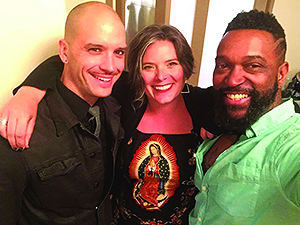
Left to right: Logan Phillips, Kristen Nelson and Roger Bonair-Agard after Logan and Roger’s reading at Casa Libre’s Fair Weather Reading Series.
Photo courtesy Kristen Nelson
“This is also where, after Maggie Golston’s downtown book shop Biblio closed down, Maggie contacted us and said, ‘Hey, I need a place for WIP (Writers In Progress, a UA MFA curated reading series) to be,’ and we housed WIP for eight to nine years.
“There was a need for Casa Libre because we were able to be a central kind of organizing unit for a bunch of different projects. I always pictured us as an octopus, where we had this central head but there were all these tentacles and each of those tentacles were organized by a person or community group. Those are the niches we filled.”
There comes a time for any writer who has worked hard on community projects for years to get to the point where they need to get back to focusing on writing. That time has come for Kristen Nelson. During her almost 14-year tenure at the helm of Casa Libre, she has been a renovator, maintenance person and landlord for her property. She went and got an MFA in creative writing from Goddard College, worked as an adjunct professor at Pima Community College for four years and currently is the program coordinator at UA’s Institute for LGBT Studies.
“That’s my trajectory of professional history, but that whole time, running Casa Libre. And for nine of the 14 years that I’ve run this place, it was unpaid, and that’s not something I want to pass on to the new executive director. Which is why I am not taking a salary this year, we’re fundraising, and we’re getting money in the bank so no one will be in that position again.”
As we circle back to chat about Casa Libre’s upcoming events – the Fair Weather Reading Series, happening mostly monthly January through May – Nelson lights up and says, “T.C. Tolbert, we haven’t talked at all about T.C.!” She shares that Tolbert was the organization’s assistant director for seven years, who started and ran the Trickhouse events with Noah Saterstrom.
“I started the Fair Weather Reading Series about two years ago, so that was the time T.C. decided to step down as the assistant director to pursue other professional opportunities, with so much love. That was when I started envisioning leaving Casa Libre myself because my best friend and collaborator claimed that opportunity for himself and I thought, ‘Oh wait, wait, and now you’re writing more?’ But I knew that I couldn’t hand over this octopus unpaid to somebody.”
Nelson and her board are in full fundraising mode, she says they are about 40% to their goal and is confident they will reach it by July 1, 2017.
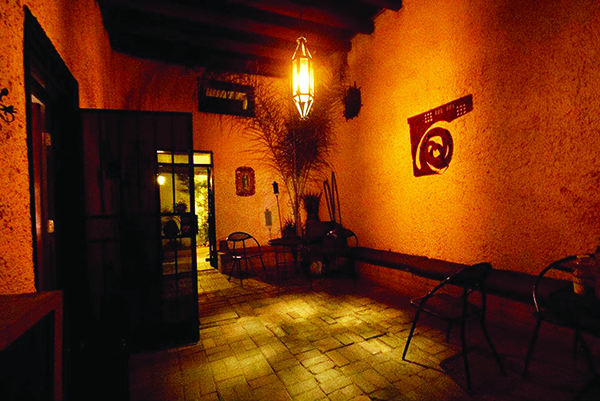
Casa Libre’s outside courtyard.
Photo courtesy Kristen Nelson
Board president Sara Wolfe Vaughan says she is “excited to see what the future holds both for Casa Libre and for Kristen. I’m truly elated that Kristen will have more time to devote to her own art. It’s something she so deserves and we need her work out in the world, maybe now more than ever. Tucson has no shortage of talented artists and I can’t wait to meet our candidates.”
Reflecting on what they are looking for in a new leader, Nelson shares that they’d “really like somebody who has some experience running events, particularly in the nonprofit world and also someone who has development experience. Someone who has the skills to continue it forward in a new way.”
To donate, visit CasaLibre.org/donate.html. The Fair Weather Reading Series is Jan. 17, 7 p.m. A $5 donation gains entrance at 228 N. 4th Ave. to hear from Garnette Cadogan, Jordan Flaherty and Yanara Friedland. Learn more at CasaLibre.org/events.html. Check out Nelson’s writings and sundries at KristenENelson.com.

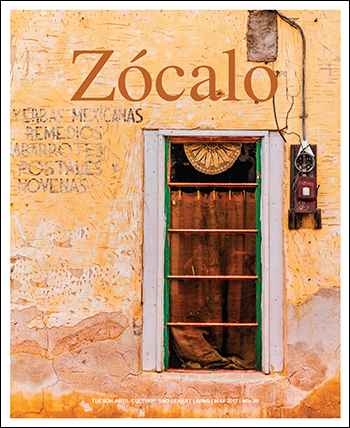
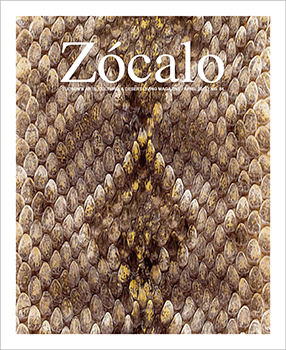
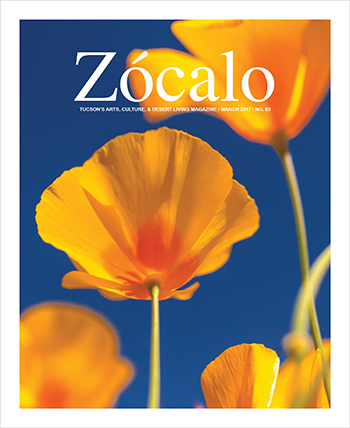
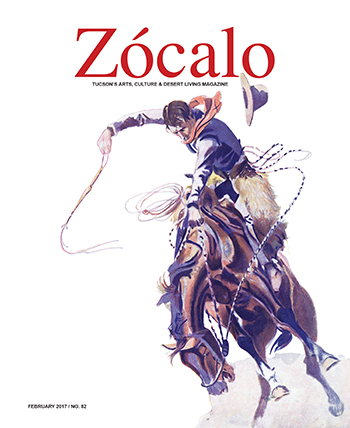




Also find us on...